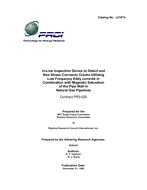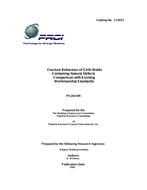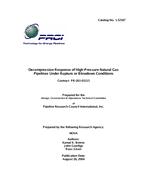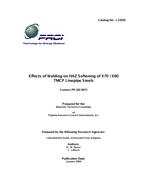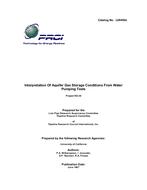PRCI PR-3-025
- In-Line Inspection Device to Detect and Size Stress Corrosion Cracks Utilizing Low Frequency Eddy Currents in Combination with Magnetic Saturation of the Pipe Wall in Natural Gas Pipelines
- Report / Survey by Pipeline Research Council International, 12/01/1992
- Publisher: PRCI
$148.00$295.00
Battelle Memorial Institute
Need: Under previous programs for the Pipeline Research Committee, Battelle has developed and field tested a low frequency eddy current instrument for detecting and characterizing stress corrosion cracks in pipelines. While a significant improvement over conventional magnetic particle inspections in some respects, the eddy current method as it was developed in these programs can only be used with surface breaking defects. Thus, it is limited to use for inspections of pipelines from the outside surface.
Benefit: In this program, we examined the use of a saturating magnetic field to allow increased penetration of the eddy current field into the pipe material, providing the ability to detect and characterize stress corrosion cracks from the interior of the pipeline. Until recently, eddy current inspections of steel were the exception not the norm, primarily because low frequency eddy current instruments were not available. In eddy current testing, the eddy current field grows smaller as it penetrates into the material being tested.
Result: The predictions of general coil characteristics and the response to defects were found to be accurate experimentally. There is an optimum skin depth at which defect sensitivity is maximized. This skin depth is approximately 50 percent of pipe wall thickness, increasing slightly for shallower defects, and is independent of the pipe's conductivity, coil frequency, lift-off, and somewhat independent of pipe permeability and coil geometry. In practice, the coil's test frequency should be selected such that the optimum skin depth is obtained for a given permeability. In all practical situations defect sensitivity for coils operating at the optimum skin depth will monotonically increase as pipeline permeability is reduced. Also, if the coil's core becomes saturated, defect sensitivity will be greatly reduced. Variations in pipeline conductivity will change defect sensitivity. As the conductivity increases, defect sensitivity will decrease. Defect sensitivity roughly increases exponentially as defect depth increases.
Related Products
PRCI PR-202-009
Fracture Behavior of Girth Welds Containing Natural Defects, Comparison with Existing Workmanship St..
$448.00 $895.00
PRCI PR-261-03115
Decompression Response of High-Pressure Natural Gas Pipelines Under Rupture or Blowdown Conditions..
$148.00 $295.00
PRCI PR-202-9635
Effects of Welding on HAZ Softening of X70 / X80 TMCP Linepipe Steels..
$448.00 $895.00
PRCI NS-38
Interpretation of Aquifer Gas Storage Conditions from Water Pumping Tests..
$50.00 $99.00

